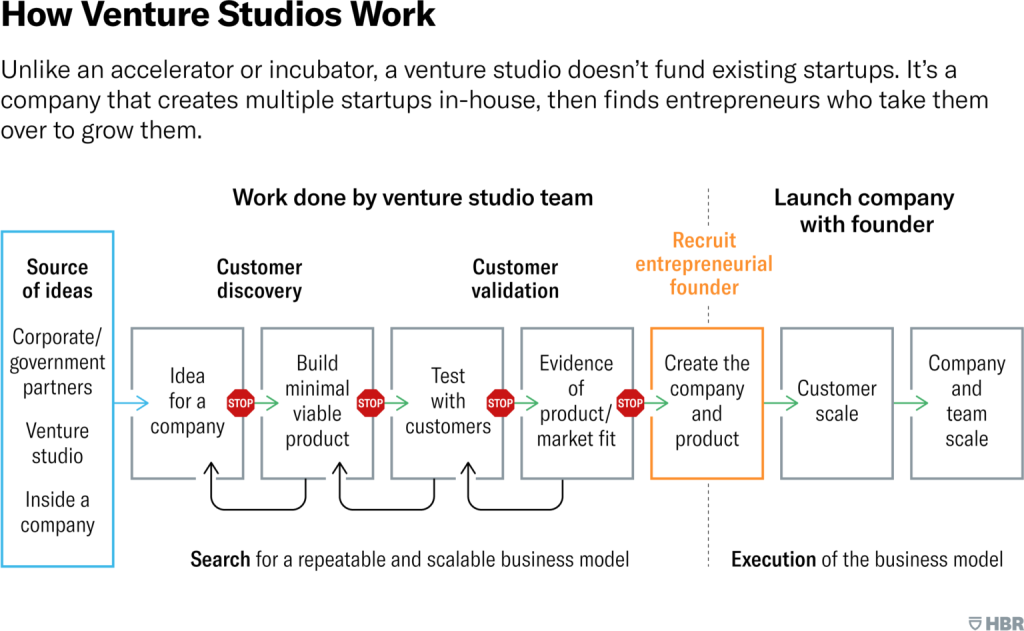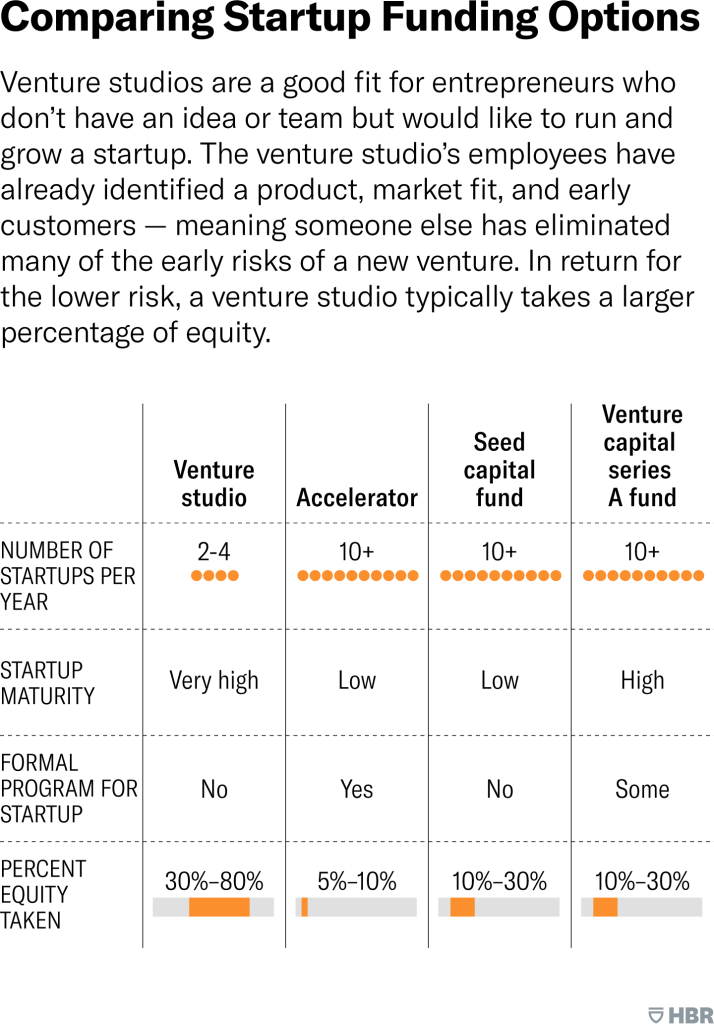
S7Clear X Venture Studio
I was at a small university in the Midwest, having coffee with Client, an up-and-coming talent in a mid-sized manufacturing firm. Client had a knack for developing small teams into successful product lines, but after ten years of working for others, he was keen on starting and growing his own company. I inquired about his knowledge of starting a business, and he mentioned the conventional path of ideation, team formation, MVP testing, seed funding, and finally, venture capital.
The client disclosed his expertise in additive manufacturing and 3D printing but lamented the difficulty in securing venture capital from coastal investors. Additionally, he was uncertain about the potential of his idea. Nevertheless, he had a burning desire to cultivate a small business into a substantial one. As we indulged in dessert, the Client asked if there were other means of starting a company besides raising capital.
As we grabbed dessert, the Client asked, “Other than raising money, are there other ways to start a company?”
I pointed out that there were.
Reducing Startup Risk
Over the past 20 years, three types of organizations have emerged to help early-stage startups reduce the risk of failure: incubators, accelerators, and venture studios. These organizations are typically founded and led by experienced entrepreneurs who have firsthand knowledge of the difference between theory and practice.
I explained to the Client that accelerators such as Y-Combinator, Techstars, and 500 Startups provide a six- to 12-week bootcamp for a cohort of startups. However, these programs seek out founders who possess technical or business model insight and have already formed a team. Accelerators offer these teams access to technical and business expertise, as well as a network of other founders and advisors. The culmination of this bootcamp is a “demo day,” where all startups in the cohort have the opportunity to pitch their companies to venture capitalists and angel investors. In some cases, the accelerator itself may provide initial funding. In exchange for participating in the accelerator program, startups typically give up 5% to 10% of their company’s equity.
Over the last two decades, there has been an emergence of three types of organizations – incubators, accelerators, and venture studios – that aim to reduce the risk of early-stage startup failure by providing assistance to teams in finding product/market fit and raising initial capital. These organizations are often founded and led by experienced entrepreneurs who have practical knowledge and can distinguish between theory and practice.
I informed the Client that there are thousands of accelerators worldwide that typically search for startups that can potentially generate venture-class returns, meaning they can grow into companies worth billions of dollars. Admission to most accelerators is through an application and interview process, and while some like Y-Combinator, Techstars, and 500 Startups are open to startups in any market, others like SOSV, IndieBio, HAX, Orbit, and dLab are more specialized.
Incubators provide shared space and resources to startups but typically offer little to no capital. Their financial models rely on membership fees that provide access to coworking spaces, resources, and operational expertise.
The Client stirred his coffee and remarked, “Accelerators may not be the right fit for where I am in my career. I don’t have a groundbreaking idea or a technical team, but I know how to develop, expand, and manage teams.”
The Alternative: Venture Studios
I recommended to the Client that venture studios might be a more suitable option for him given his skills and desire to start his own company. Unlike accelerators, venture studios do not invest in existing startups but create their own startups by incubating their own or their partners’ ideas.
The studio’s internal team develops the minimum viable product, validates the idea by finding product/market fit and early customers, and recruits entrepreneurial founders to run and scale those startups if the idea passes a series of “Go/No Go” decisions based on milestones for customer discovery and validation. Examples of successful companies that have emerged from venture studios include Overture, Twilio, Bitly, Aircall, and Moderna.
I suggested that the Client view a venture studio as an “idea factory” with its own full-time employees who search for product/market fit and a repeatable and scalable business model.

Most venture studios create and launch several startups each year. These have a greater success rate than those that come out of accelerators or traditional venture-funded companies. That’s because unlike accelerators, which operate on a six- to 12-week cadence, studios don’t have a set timeframe. Instead, they search and pivot until product/market fit is found. Unlike an accelerator or a VC firm, a venture studio kills most of their ideas that can’t find traction and won’t launch a startup if they can’t find evidence that it can be a scalable and profitable company.

There are four main types of venture studios:
- Tech transfer studios, such as America’s Frontier Fund, work with companies and/or government labs to source ideas and intellectual property. They then transfer the IP and build the startup inside the venture studio.
- Corporate studios, such as Applied Materials, source ideas and intellectual property inside their own company. They then build the startup inside a separate corporate venture studio inside the company.
- A niche studio is a standalone venture studio that generates its own ideas and IP in a specific industry and domain — for example, Flagship Pioneering, which is focused on health care and incubated LS18, the company that became Moderna.
- An industry-agnostic studio, such as Rocket Internet, is a standalone venture studio that generates its own ideas and IP and is industry and market agnostic.
Today there are around 720+ venture studios across the world — half are in Europe. In both North America and Europe, many venture studios in non-major cities are funded by government agencies to stimulate local growth, at times with matching donations from companies. These studios have different metrics than startup studios whose limited partners are private family offices or venture capitalists.
Why Would an Entrepreneur Join a Venture Studio?
While we were on our second cup of coffee, I told Carlos about the downside to joining a company created by a venture studio — how much equity/ownership they take.
In contrast with an accelerator that takes 5% to 10% of a startup’s equity, venture studios take anywhere from 30% to 80%. This is because companies exiting a venture studio have been handed a startup that has de-risked of much of the early-stage startup process. (There’s a direct correlation between the amount of equity a venture studio takes and their belief in how much they want their founding CEO to be an entrepreneur versus executor.)
Why would an entrepreneur join a venture studio and give up the majority of their company rather than go to an accelerator? Most accelerators tend to look for a “founder type” — a stereotypical techie, fresh out of college, who already has an idea and cofounders.
Most people don’t fit that pattern. Yet many are more than capable of taking an idea that’s been stress-tested and validated and building it.
What To Look for in a Venture Studio
As we got up to leave, the Client asked, “How would I know whether the venture studio is a good one?”
It was a great question. While there are no hard-and-fast rules, I advise entrepreneurs to ask these four questions:
- Is the studio run by a former founder, and does it have former founders as full-time employees? The most successful venture studios are founded by entrepreneurs who have previously built companies with $10+M in revenue and had 100+ employees.
- What percentage of equity are they asking for? The answer will be directly proportional to what they think your value is. Firms asking for greater than 60% are actually hiring an employee rather than a founder.
- Do you want a studio with specific expertise? Studios that focus on specific niches and industries can build a deep bench of domain experts — e.g., a founder, advisors, and mentors — who are experts in this one field.
- Do they have enough funding? Watch out for zombie studios. If you’ve given away a majority of your company to a studio, it would be helpful to have them around for support after you’ve started. If they don’t have enough funding to keep the lights on for several years, you’re on your own. Make sure your studio has raised more than $10m in funding.


